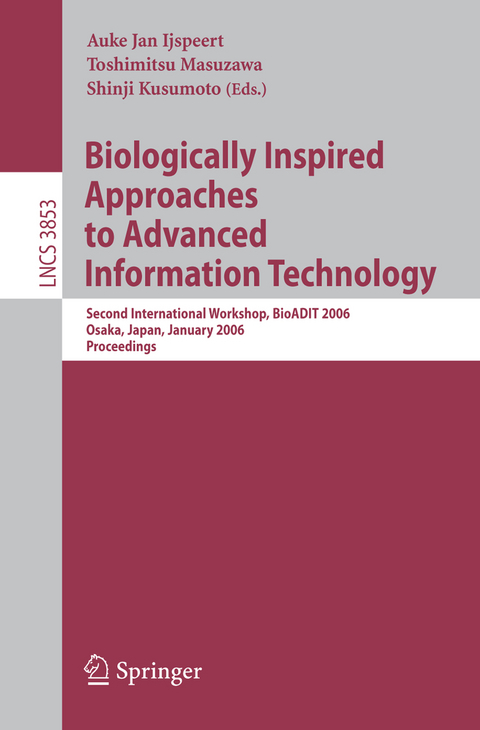
Biologically Inspired Approaches to Advanced Information Technology
Springer Berlin (Verlag)
978-3-540-31253-6 (ISBN)
Invited Talks.- Design of Synthetic Gene-Metabolic Circuits.- Morphological Computation: Connecting Brain, Body, and Environment.- Single Molecule Nano-Bioscience.- Robotics.- Evolving the Walking Behaviour of a 12 DOF Quadruped Using a Distributed Neural Architecture.- Robot Control: From Silicon Circuitry to Cells.- Networking I.- Proposal and Evaluation of a Cooperative Mechanism for Pure P2P File Sharing Networks.- Resilient Multi-path Routing Based on a Biological Attractor Selection Scheme.- Packet Classification with Evolvable Hardware Hash Functions – An Intrinsic Approach.- Biological Systems.- Emergence of Two Power-Laws in Evolution of Biochemical Network; Embedding Abundance Distribution into Topology.- Microbial Interaction in a Symbiotic Bioprocess of Lactic Acid Bacterium and Diary Yeast.- Responses of Fluctuating Biological Systems.- Analysis of Fluctuation in Gene Expression Based on Continuous Culture System.- Self-organization.- Bio-inspired Computing Machines with Self-repair Mechanisms.- Perspectives of Self-adapted Self-organizing Clustering in Organic Computing.- MOVE Processors That Self-replicate and Differentiate.- Evolutionary Computation.- The Evolutionary Emergence of Intrinsic Regeneration in Artificial Developing Organisms.- Evaluation of Fundamental Characteristics of Information Systems Based on Photonic DNA Computing.- Hybrid Concentration-Controlled Direct-Proportional Length-Based DNA Computing for Numerical Optimization of the Shortest Path Problem.- Modeling and Imaging.- Modeling of Trees with Interactive L-System and 3D Gestures.- New Vision Tools from the Comparative Study of an “Old” Psychophysical and a “Modern” Computational Model.- Photonic Information Techniques Based on Compound-Eye Imaging.- Attractor Memory withSelf-organizing Input.- Networking II.- Bio-inspired Replica Density Control in Dynamic Networks.- Improving the Robustness of Epidemic Communication in Scale-Free Networks.- On Updated Data Dissemination Exploiting an Epidemic Model in Ad Hoc Networks.- Posters.- Modeling of Epidemic Diffusion in Peer-to-Peer File-Sharing Networks.- A High-Throughput Method to Quantify the Structural Properties of Individual Cell-Sized Liposomes by Flow Cytometry.- A User Authentication System Using Schema of Visual Memory.- A Consideration of Application of Attractor Selection to a Real-Time Production Scheduling.- Bio-inspired Organization for Multi-agents on Distributed Systems.- m-ActiveCube; Multimedia Extension of Spatial Tangible User Interface.- Biologically Inspired Adaptive Routing by Mimicking Enzymic Feedback Control Mechanism in the Cell.- An Interest-Based Peer Clustering Algorithm Using Ant Paradigm.
| Erscheint lt. Verlag | 11.1.2006 |
|---|---|
| Reihe/Serie | Lecture Notes in Computer Science | Theoretical Computer Science and General Issues |
| Zusatzinfo | XIV, 388 p. |
| Verlagsort | Berlin |
| Sprache | englisch |
| Maße | 155 x 235 mm |
| Gewicht | 609 g |
| Themenwelt | Informatik ► Software Entwicklung ► User Interfaces (HCI) |
| Mathematik / Informatik ► Informatik ► Theorie / Studium | |
| Schlagworte | ad hoc networks • Algorithm analysis and problem complexity • Algorithmic Learning • algorithms • Ant Algorithms • Architecture • Biocomputing • bioinspired computing • Biologically Motivated Computing • Distributed Systems • Dynamic Networks • Evolvable Systems • Genetic algorithms • Image Processing • Modeling • Multimedia • peer-to-peer-systems • real-time • Replication • robot • Robotic • Robotics • Self-Organization • Self-Repair • Topology |
| ISBN-10 | 3-540-31253-6 / 3540312536 |
| ISBN-13 | 978-3-540-31253-6 / 9783540312536 |
| Zustand | Neuware |
| Haben Sie eine Frage zum Produkt? |
aus dem Bereich


